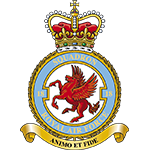

RAF No 273 Squadron
RAF No 273 Squadron
Motto: none
Formed at Burgh Castle on 30 July 1918 from No's 470, 485, 486 (Fighter) & 534 (Light Bomber) Flights, it was equipped with DH4, DH9, BE2c and Camels and conducted coastal reconnaissance sorties along the East Coast. The Camels provide fighter protection to the two-seater reconnaissance machines, which were supplemented by some DH9As in September. The squadron disbanded on 5 July 1919.
The squadron reformed at China Bay, Ceylon on 1 August 1939, equipped with six Vickers Vildebeest torpedo bombers. It also operated four Fairey Seals belonging to the Station Flight, and with these two types it carried out coastal patrols, but the lack of enemy activity in the area led to it carrying out anti-aircraft co-operation duties.
In March 1942, the squadron re-equipped with Fairey Fulmers, with half of the personnel also being naval. On 9 April a Japanese carrier force attacked Ceylon and the squadron lost one aircraft, after which the squadron began reconnaissance operations looking for further enemy vessels. When no further vessels were found the squadron resumed its defensive role, re-equipping with Hurricanes in August 1942 and Spitfire VIIIs in March 1944.
The squadron eventually joined in the offensive against the Japanese in July 1944 when it moved to Burma and began ground attacks and escort duties in support of the 14th Army. With the end of hostilities it moved to Don Muang in Siam (Thailand) on 11 September 1945 and twelve days later moved to Tan Son Nhut in French Indo China (Vietnam), where it disbanded on 31 January 1946
No Badge Authorised
Squadron Codes used: HH Aug 1939 - Sep 1939; MS Mar 1944 - Jan 1946

 Editor for Asisbiz: Matthew Laird Acred
Editor for Asisbiz: Matthew Laird Acred
 Editor for Asisbiz: Matthew Laird Acred
Editor for Asisbiz: Matthew Laird Acred